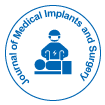Orthopedic Robotics: Transforming Surgical Precision and Patient Outcomes
Received: 01-Nov-2024 / Manuscript No. jmis-25-158694 / Editor assigned: 04-Nov-2025 / PreQC No. jmis-25-158694 (PQ) / Reviewed: 18-Nov-2024 / QC No. jmis-25-158694 / Revised: 25-Nov-2024 / Manuscript No. jmis-25-158694 (R) / Published Date: 30-Nov-2024
Abstract
Orthopedic robotics represents a cutting-edge advancement in the field of surgery, offering enhanced precision, minimal invasiveness, and improved patient outcomes. Robotic systems, integrated with advanced imaging and artificial intelligence, allow orthopedic surgeons to plan and execute surgeries with unprecedented accuracy. These technologies have revolutionized joint replacement procedures, spinal surgeries, and fracture repairs, leading to faster recovery times, reduced complications, and better long-term results. This paper explores the current state of orthopedic robotics, examining key technologies, applications, and clinical benefits. It also discusses the challenges, future developments, and the growing role of artificial intelligence in shaping the future of orthopedic surgeries.
Keywords
Orthopedic robotics; Robotic-assisted surgery; Precision surgery; Joint replacement; Spinal surgery; Artificial intelligence in surgery; Minimally invasive surgery; Surgical navigation
Introduction
Orthopedic surgery has undergone significant advancements over the past few decades, with technology playing a pivotal role in transforming surgical practices. Among these innovations, robotic-assisted surgery has emerged as one of the most promising developments in the field of orthopedics. By incorporating advanced robotics, imaging systems, and artificial intelligence (AI), orthopedic robots offer surgeons enhanced precision, improved surgical outcomes, and minimized invasiveness. These systems are designed to aid in procedures such as joint replacements, spinal surgeries, and complex fracture repairs, allowing for personalized treatment plans and a more tailored approach to surgery [1]. The integration of robotic technologies has not only improved the accuracy of implant placements and surgical interventions but has also contributed to faster recovery times and a reduction in postoperative complications. Despite the increasing adoption of robotic systems in orthopedic surgeries, challenges such as high costs, surgeon training, and system reliability remain. This article delves into the various orthopedic robotic technologies currently in use, reviews their clinical applications, and examines the outcomes that have been achieved through robotic-assisted procedures [2-5]. The objective is to provide a comprehensive overview of orthopedic robotics and discuss its potential to revolutionize surgical practices and patient care.
Methodology
To assess the current landscape of orthopedic robotics, a systematic review of recent studies, clinical trials, and technological advancements in robotic-assisted orthopedic surgeries was conducted. The following methodology was used:
Literature review: A thorough review of existing literature was performed using electronic databases such as PubMed, Google Scholar, and Science Direct [6]. Keywords such as orthopedic robotics, robotic-assisted surgery, joint replacement, spinal surgery robotics, and AI in orthopedics were used to identify relevant articles published in the past five years [7]. The focus was on peer-reviewed studies, clinical trials, and technical reports.
Analysis: The data from the studies were analyzed to identify trends and patterns in the outcomes of robotic-assisted surgeries [8,9]. This included comparing robotic systems' effectiveness in various orthopedic applications, assessing their clinical impact, and discussing patient satisfaction and cost-effectiveness. Expert opinions interviews with orthopedic surgeons and robotic system manufacturers were conducted to gather insights into the practical implementation of robotic technologies, challenges faced in the clinical setting, and future trends in robotic surgery [10].
Conclusion
Orthopedic robotics has emerged as a transformative force in modern surgery, offering enhanced precision, improved surgical outcomes, and significant benefits for patients. Robotic-assisted systems, integrated with advanced imaging technologies and artificial intelligence, enable orthopedic surgeons to perform procedures with greater accuracy, particularly in joint replacements, spinal surgeries, and complex fracture repairs. The ability to create personalized surgical plans based on real-time data has improved the overall effectiveness of surgeries, leading to quicker recovery times, reduced complication rates, and better long-term results. Despite the promising advantages, challenges such as high initial costs, the need for specialized training, and the integration of robotic systems into existing surgical workflows remain. However, with continuous advancements in robotic technology, these barriers are expected to decrease over time, making robotic-assisted orthopedic surgeries more accessible and cost-effective. Additionally, the growing role of artificial intelligence and machine learning in refining surgical techniques and decision-making further enhances the potential for orthopedic robotics to revolutionize patient care. In the future, the expansion of robotic-assisted surgery in orthopedics will likely lead to even greater innovations, such as minimally invasive procedures, improved patient-tailored treatments, and the integration of augmented reality (AR) for real-time surgical navigation. The continued development and refinement of robotic technologies, along with the increasing adoption of AI and machine learning, promise to further elevate the precision and safety of orthopedic surgeries, ultimately transforming the way orthopedic conditions are treated worldwide.
Citation: Zachary N (2024) Orthopedic Robotics: Transforming Surgical Precision and Patient Outcomes. J Med Imp Surg 9: 256
Copyright: © 2024 Zachary N. This is an open-access article distributed under the terms of the Creative Commons Attribution License, which permits unrestricted use, distribution, and reproduction in any medium, provided the original author and source are credited
Share This Article
Recommended Conferences
42nd Global Conference on Nursing Care & Patient Safety
Toronto, CanadaRecommended Journals
Open Access Journals
Article Usage
- Total views: 382
- [From(publication date): 0-0 - Apr 28, 2025]
- Breakdown by view type
- HTML page views: 211
- PDF downloads: 171
